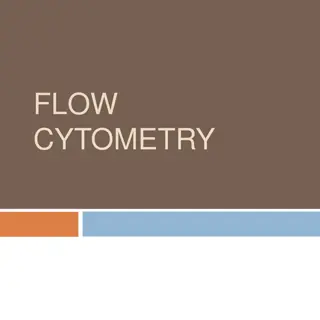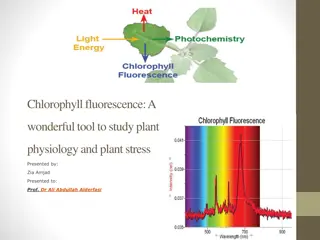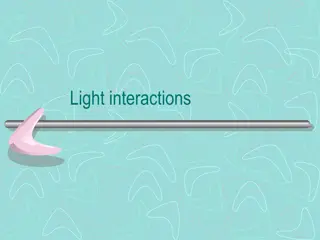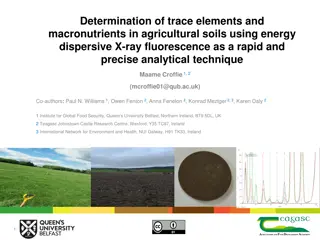Insights into Raindrop Size Distribution and Precipitation Intensity through Radar Technology
Vertical momentum of impacting raindrops can be converted into an electric pulse to analyze raindrop size distribution. Disdrometers using video cameras can directly count raindrops for sizing. Radar technology provides superior data on precipitation accumulation and intensity by measuring radar ref
4 views • 9 slides
Understanding Photosynthesis and Limiting Factors
Photosynthesis is an endothermic reaction that takes in energy from its surroundings. The law of limiting factors explains how various factors such as light intensity, temperature, and CO2 concentration can impact the rate of photosynthesis. Additionally, the concept of the inverse square law helps
7 views • 45 slides
Advanced Microscopy Techniques and Applications in Cell Biology
Explore the diverse world of advanced microscopy techniques in cell biology, from confocal and super-resolution imaging to Fluorescence Resonance Energy Transfer (FRET) microscopy and Fluorescence Recovery After Photobleaching. Discover the latest methods, considerations, and applications for studyi
3 views • 21 slides
Improving Heat Rate Efficiency at Illinois Coal-Fired Power Plants
Heat rate improvements at coal-fired power plants in Illinois are crucial for enhancing energy conversion efficiency, reducing carbon intensity, and minimizing pollution. By increasing the heat rate/efficiency by 6%, these plants can generate more electricity while burning the same amount of coal. T
2 views • 11 slides
High-Intensity Sweeteners Market Projected to Reach $5.37 Billion by 2034
The global high-intensity sweeteners market is projected to experience significant growth through 2034. High-intensity sweeteners are widely used as sugar substitutes due to their ability to provide the desired sweetness without the calories. \n
0 views • 5 slides
High-Intensity Sweeteners Market Projected to Surpass $5.37 Billion by 2034
The High-Intensity Sweeteners Market is projected to reach $5.37 billion by 2034, growing at a CAGR of 5% during the forecast period from 2024 to 2034.\n
0 views • 4 slides
Understanding Fluorimetry: Principles and Applications
Fluorimetry is the measurement of fluorescence intensity at a specific wavelength using instruments like filter fluorimeters. It involves the excitation of molecules by radiation, causing electron promotion and emission of radiation. This process includes states like singlet and triplet, with relaxa
3 views • 45 slides
Understanding Earthquakes: Causes, Effects, and Intensity Factors
Earthquakes are sudden shaking movements of the Earth's surface caused by various factors like tectonic plate movements, volcanic eruptions, mining, and construction. They result in ground shaking, rupture, tsunamis, and landslides, with intensity influenced by factors such as distance from the epic
0 views • 10 slides
Understanding Flame Photometry and Its Applications
A photoelectric flame photometer is utilized in inorganic chemical analysis to determine metal ion concentrations such as sodium, potassium, lithium, barium, and calcium. The photometer measures light intensity emitted when elements are exposed to a flame. By controlling flame color intensity, the d
1 views • 25 slides
Understanding Fluorimetry: Principles, Applications, and Instrumentation
Fluorimetry is a technique that measures fluorescence intensity of molecules when excited by radiation. It involves the promotion of electrons from ground to excited states, leading to emission of radiation. This process includes singlet and triplet states, as well as relaxation mechanisms like Coll
0 views • 45 slides
Guideline for Statin Management in High-Risk Groups - 2018 ACC/AHA
This guideline outlines the management of blood cholesterol in high-risk groups according to the 2018 ACC/AHA recommendations. It discusses the overall approach, different statin management groups, justification for statin use in high-risk populations, high and moderate-intensity statin therapy, and
1 views • 14 slides
Understanding Fluorescence Analysis in Pharmaceutical Sciences
Fluorescence analysis is a crucial technique in pharmaceutical analysis, involving the emission of radiation by molecules when excited at specific wavelengths. Factors influencing fluorescence, such as concentration, light intensity, adsorption, oxygen presence, pH, temperature, viscosity, and photo
2 views • 26 slides
Understanding Fluorescence Microscopy: Principles and Applications
Fluorescence microscopy, pioneered by British scientist Sir George G. Stokes, reveals hidden details in specimens using fluorescent dyes that emit light of longer wavelengths. This innovative technique allows for visualization of cellular components that are otherwise colorless under conventional mi
0 views • 19 slides
Investigating the Effect of Light Intensity on Photosynthesis Using Pondweed
Explore the impact of light intensity on photosynthesis rates by conducting a practical experiment with aquatic plants like pondweed. Learn about the factors influencing photosynthesis and how to measure its rate effectively through counting oxygen bubbles produced. Follow a step-by-step guide to se
0 views • 12 slides
Understanding Flow Cytometry: Principles and Applications
Flow cytometry is a powerful technique for analyzing properties of cell populations in various biological samples. By measuring size, complexity, and fluorescence intensity, this method allows for quantitative and qualitative analysis of cells. This comprehensive guide covers the basic principles, c
0 views • 38 slides
High-Intensity Sweeteners Market
The High-Intensity Sweeteners Market is expected to grow to $5.37 billion by 2034, with a compound annual growth rate (CAGR) of 5% over the forecast period from 2024 to 2034.\n
0 views • 3 slides
Exploring the Fascinating World of Photophysics and Luminescence
Dive into the intriguing realm of photophysics, where various emission and loss processes lead to luminescence phenomena such as fluorescence, phosphorescence, and chemiluminescence. Discover the beauty of bioluminescence in nature, from fireflies to bioluminescent red tide events. Explore the mecha
0 views • 16 slides
NC22Plex STR Detection Kit: Advanced 5-Color Fluorescence Detection System
Explore the cutting-edge NC22Plex STR Detection Kit from Jiangsu Superbio Biomedical, offering a 5-color fluorescence detection system suitable for multiple applications. Enhance your research capabilities with this innovative product designed for precision and efficiency.
0 views • 20 slides
Understanding Flow Cytometry: Principles and Applications
Flow cytometry is a powerful technology used to analyze the properties of cell populations. By measuring size, complexity, and fluorescence intensity, this method provides valuable insights into various biological samples. The process involves labeling cells with fluorescent markers, passing them th
2 views • 38 slides
High-Intensity Sweeteners Market
With a projected value of $5.37 billion by 2034 and a CAGR of 5% during the 2024\u20132034 period, the High-Intensity Sweeteners Market is set for substantial growth. \n
0 views • 3 slides
Understanding Light Intensity Variation in Different Sources
Explore the correlation between light intensity and efficiency in various light sources through an intriguing experiment. Delve into the theoretical framework and practical applications to grasp the essence of light intensity and its distribution. Uncover the factors influencing the efficiency of li
0 views • 21 slides
7th IOTA/FAST Collaboration Meeting & Workshop on High-Intensity Beams
The 7th IOTA/FAST Collaboration Meeting & Workshop on High-Intensity Beams in Rings, led by Alexander Valishev, featured discussions, emergency procedures, logistics, and a structured meeting agenda focusing on experimentation, research, and future opportunities.
0 views • 4 slides
Exploring Fluorescence Microscopy and High-Speed Cameras in Modern Biology
Delve into the fascinating world of fluorescence microscopy and high-speed cameras in biology through topics such as detectors for microscopy, Nyquist criterion, visualizing hearing in vivo, and temporal resolution insights. Learn about techniques, equipment, and practical considerations in utilizin
1 views • 69 slides
Understanding Low-Intensity DoS Attacks on BGP Infrastructure
Low-intensity Denial of Service (DoS) attacks present a new challenge in cyber warfare, blending in with regular traffic to target communication channels like HTTP, SMTP, and DNS. These attacks require multiple participating hosts to flood the target with useless packets, gradually overloading serve
0 views • 25 slides
Understanding Ultrasound Transducers: Applications and Functionality
Ultrasound transducers play a crucial role in medical imaging by converting electrical signals into ultrasonic energy for tissue penetration and image creation. This technology utilizes focused transducers to enhance resolution and penetration, while also managing beam intensity. The article delves
0 views • 24 slides
Understanding Chlorophyll Fluorescence in Plant Physiology
Chlorophyll fluorescence is a powerful tool developed in the 1990s for studying plant physiology and stress. It provides insights into photosynthetic processes at different levels, from subcellular to canopy. By measuring chlorophyll fluorescence, researchers can assess the efficiency of photosynthe
0 views • 16 slides
Understanding Light Intensity: Measuring Different Light Sources
Explore the concept of light intensity by measuring various light sources and their efficiency. Through practical experiments, understand the relationship between light intensity and the output of different light sources. Theoretical frameworks, practical applications, and key concepts are discussed
0 views • 21 slides
Academic Intervention Library Overview
Explore the Intervention Library for academic and behavior interventions, accessed through OKMTSS. Filter interventions by grade band, intensity level, and group size. Understand grade band considerations and intervention intensity tiers. Learn about the recommended group sizes and how to choose the
0 views • 15 slides
Ion Beam Intensity Enhancement Through Electron Heating in Collider Experiments
The study discusses electron heating of ions in collider experiments at the Collider V. ParkhomchukBINP facility in Novosibirsk. It explores the effects of electron cooling on ion beams, ion beam oscillations, losses, and ion beam intensity enhancement. Various factors such as ion charge, classical
0 views • 9 slides
Optimised Live/Dead Fluorescence Spectrometry for Antimicrobial Susceptibility Testing
This study focuses on the optimisation of live/dead fluorescence spectrometry for rapid antimicrobial susceptibility testing. The research uses fluorescent dyes to distinguish between live and dead cells, providing a potential method for quick antimicrobial resistance diagnostics. The experiment inv
0 views • 16 slides
Applications and Importance of X-ray Fluorescence Spectroscopy in Analytical Chemistry
X-ray Fluorescence Spectroscopy (XRF) is a vital analytical technique used for qualitative and quantitative analysis of elements based on their X-ray emission characteristics. Dr. Uma Sharma, a Professor at Vikram University, details various X-ray analytical methods, including X-ray emission, Auger
0 views • 21 slides
Understanding Intensity Noise and Angular Distribution Measurements in LED Selection
The measurements focus on intensity noise and angular distribution to address variations in LED performance observed in LIGO papers. The study aims to investigate intensity noise dependence on LED current, differences between LED batches, and comparisons between them.
0 views • 8 slides
Chicken Wing Sauce Consumer Test Analysis
Analysis of consumer preferences and feedback on different chicken wing sauces based on overall liking, flavor intensity, garlic flavor intensity, honey flavor intensity, and amount of sauce. The study includes crosstabulations and mean graphs to evaluate category liking attributes and jar assessmen
0 views • 12 slides
Understanding Raster Scan CRT Monitors in Information Technology
Raster Scan CRT Monitors are a common graphical output device used in Information Technology. They consist of components like the electron gun, control electrodes, and phosphor-coated screen. The electron beam emitted uses electromagnetic fields to direct and focus on specific spots on the screen. T
0 views • 11 slides
Understanding Light Interactions: Reflection, Absorption, and Fluorescence
Explore the fascinating world of light interactions, where light can be reflected, absorbed, or transmitted based on the nature of the object it encounters. Learn about absorption in different materials, fluorescence, phosphorescence, and the concepts of specular and diffuse reflection.
0 views • 17 slides
Rapid Analysis of Soil Macronutrients Using Energy Dispersive X-ray Fluorescence
Determination of trace elements and macronutrients in agricultural soils is crucial for crop productivity. This study highlights the advantages, challenges, and objectives of using energy dispersive X-ray fluorescence for rapid and precise analysis. The method requires minimal sample preparation, co
0 views • 10 slides
Factors Affecting Algal Ecology: Light Intensity Impacts on Algae Growth and Composition
Light intensity plays a crucial role in the growth and composition of algae. Algae undergo photoadaptation processes to adjust to varying light levels, affecting their photosynthetic efficiency and cellular properties. High light intensity can lead to photoinhibition and changes in cellular composit
0 views • 19 slides
Machine Learning Applications for EBIS Beam Intensity and RHIC Luminosity Maximization
This presentation discusses the application of machine learning for optimizing EBIS beam intensity and RHIC luminosity. It covers topics such as motivation, EBIS beam intensity optimization, luminosity optimization, and outlines the plan and summary of the project. Collaborators from MSU, LBNL, and
0 views • 23 slides
Challenges and Design of High-Intensity Accumulator for Neutrino Experiments
The presentation discusses the challenges faced in designing an accumulator for high-intensity particle beams in neutrino experiments at ESS Lund, with a focus on beam loss management, injection efficiency, and intense beam physics issues. The design considerations include beam holding capacity, bea
0 views • 30 slides
Microscopic Techniques in Cell Biology: Lessons and Labs Overview
Explore the fascinating world of optical microscopy in cellular biology, covering topics such as image formation, contrasting techniques, fluorescence microscopy, live-imaging techniques, and quantitative microscopy. Dive into the principles behind various microscopy techniques and experimental labs
0 views • 7 slides







































